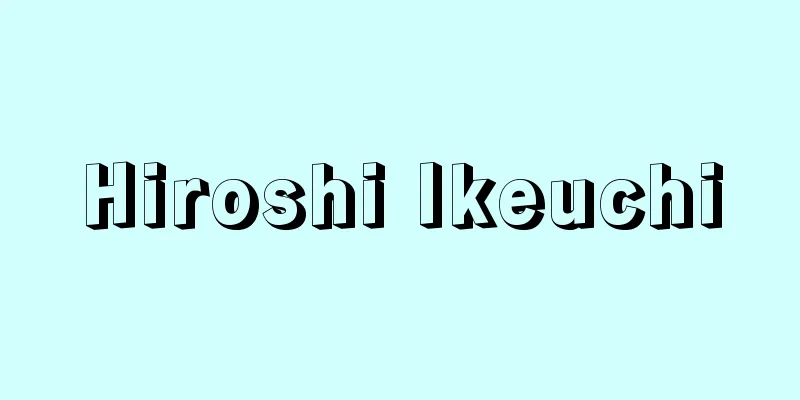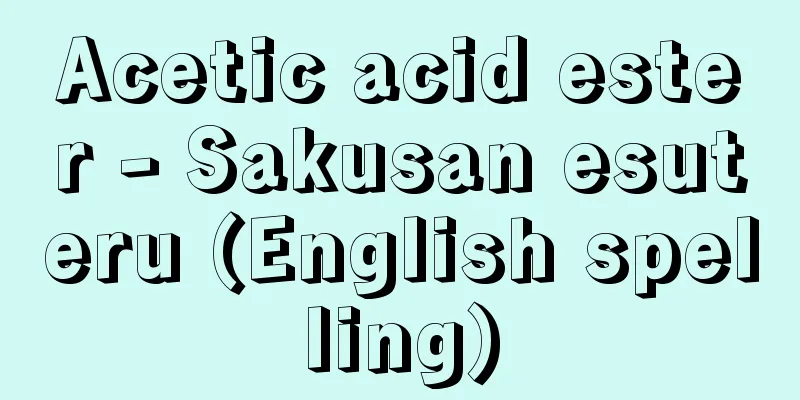Yuzen

|
Abbreviation of Yuzen-zome. A colorful pattern dyeing style that appeared in the Edo period. As the name suggests, it is said to have been created by Miyazaki Yuzensai, an artist who lived in Kyoto during the Genroku period (1688-1704). However, the years of Yuzensai's birth and death are unclear, and therefore the events surrounding the founding of Yuzen-zome are unclear. According to documents, "Yuzen Hinagata" was published in 1688 (Genroku 1), and in terms of documents, a Murasaki Shikibu Yuzen-zome hanging scroll at the Tokyo National Museum has an inscription dated 1720, which is noteworthy as a clear date, but the oldest reliable document at present is the baby clothes of Date Tsunamura, who was born in 1669 (Kanbun 9). According to such materials, it is believed that Yuzen dyeing developed from the mid-to-late 17th century by combining the paste-resist dyeing and pull-dyeing techniques of existing small-pattern stencil dyeing with the line drawing, shading, and color-insertion techniques of Tsujigahana dyeing, and that Yuzensai was probably an outstanding artist or designer who appeared around the time this style reached its peak. Today, there are many different types of Yuzen dyeing techniques, due to the development of ancillary techniques that have developed over a long period of time and new techniques in response to changes in materials, but the basis of the technique is to first draw the outline of the pattern on the fabric using glue (such as glue made from glutinous rice or wheat flour). There are two techniques for this: toothpick glue, in which sticky glue is applied to the end of a thin stick and then stretched while laying it down, and tube glue, in which glue is poured into a paper tube with a thin hole at the end and then lines are drawn while pressing with a finger, but the former is no longer used. Once the glue has been laid down, the pattern is painted. Today, chemical dyes are the norm, but in the case of natural dyes, pigments are used, and dyes that have been made into pigments suitable for paint-dyeing (such as indigo sticks and hard red) were often used. Currently, the fabric is steamed to fix the color, but in the past, soybean soup was used. After the coloring is complete, the fabric is covered with a thick layer of glue and dyed using a brush. After the dyeing is complete, the fabric is thoroughly dried and washed with water to remove the glue, revealing a colorful pattern bordered by fine stitch lines. The above is the most basic technique of Yuzen dyeing, but its distinctive features are that it is hand-painted and that the dyeing method has changed from the traditional bath dyeing to paint dyeing (although bath dyeing is sometimes used in parts), which makes it much easier and more effective to create colorful, picturesque kosode patterns with shading and shading than traditional embroidery, shibori (tying in Tsujigahana), or drawings. It can certainly be said to have been a groundbreaking technological advancement in the history of Japanese dyeing crafts. Of course, Yuzen dyeing was most popular in Kyoto, its birthplace, from the early days, as the Kamogawa dyeing, but there is also a style commonly known as Kaga Yuzen. This is not a difference in technique, but rather a difference in style in color scheme and pattern composition. The style, which uses bright colors such as red, purple, green, and indigo with gradations, is reminiscent of the Nuihaku style of the Azuchi-Momoyama period (late 16th century), and has a sense of conveying the old style of Yuzen dyeing. It makes sense that this was traditionally transmitted to Kaga Province (Ishikawa Prefecture), which is far from the center, but there is much doubt that this style of Yuzen dyeing was only practiced in Kaga and that it is called Kaga Yuzen in that sense. Yuzen dyeing, which is primarily colorful, showed another advancement after the Meiji period when the difficulty of using dyes in pigment form was eliminated by the use of chemical dyes, making color creation easier. With the invention of the technique of copying paste, which adds paste to dyes, around 1877 (Meiji 10), the technique of stencil printing, in which the dye is printed directly onto a stencil, was developed, and today it is widely practiced as a popular form of Yuzen dyeing, alongside hand-painted Yuzen. In addition, various new techniques are being introduced, such as the use of raw rubber instead of rice paste, or the use of wax in addition, and the tradition of Yuzen dyeing, a uniquely Japanese dyeing method, will continue to live on with the times, adding more diversity in the future. [Yamabe Tomoyuki] [Reference] | | |©Ishikawa Prefecture Tourism Federation "> Kaga Yuzen coloring Source: Shogakukan Encyclopedia Nipponica About Encyclopedia Nipponica Information | Legend |
|
友禅染めの略。江戸時代に現れた多彩な模様染め。名称が示すように、元禄(げんろく)年間(1688~1704)ごろ京都にいた絵師宮崎友禅斎によって創始されたと伝えられている。しかし、友禅斎は生没年も判然としておらず、したがって友禅染めの創始に関する事跡もはっきりしたことはわからない。文献に現れたところでは、1688年(元禄1)に『友禅ひながた』が刊行されており、また資料のうえでは、東京国立博物館にある紫式部友禅染掛幅に享保(きょうほう)5年(1720)の銘があり、年代のはっきりしたものとして注目されるが、現在のところもっとも古い確かな資料としては、1669年(寛文9)に生まれた伊達(だて)綱村の産着(うぶぎ)がある。このような資料によって、友禅染めというものは、17世紀なかばから後半にかけて、それまでにあった小紋系の型染めにおける糊防染(のりぼうせん)・引き染めの技術と、辻(つじ)が花染めの線描(か)き・隈取(くまどり)・色差しなどの技術が一つになって発達してきたもので、友禅斎はおそらくその完成期ごろに現れた優れた作家か意匠家(デザイナー)ではなかったかと思われる。 友禅染めの技術は、現在においては、長い間に発達した付帯的な技術や、材料の変化に伴う新しい技術の開発などによって、多種多様なものが行われているが、その根本となるのは、まず布地の上へ糊(のり)(糯米(もちごめ)を主剤とするものや小麦粉を用いる一珍(いっちん)糊など)を用いて模様の輪郭を描くことである。これには粘り気の強い糊を細い棒の先につけて、これを伸ばしながら置いていく楊枝(ようじ)糊の技法と、先端に細い穴のあいた口金のついた渋引きの紙筒へ糊を入れ、これを指頭で圧しながら線を描いていく筒糊(つつのり)の技法とがあるが、前者は現在は行われていない。糊置きが終わると模様の部分に色差しが行われる。現在は化学染料を主とするが、天然染料の場合は顔料を用いたり、また染料を塗り染めに適するように顔料化したもの(藍棒(あいぼう)や堅紅(かたべに)など)が多く用いられた。色を定着させるためには、現在は「蒸し」、昔は豆汁(ごじる)が用いられた。色差しが終わると、その上を伏せ糊で厚く覆って地染めが行われるが、これは刷毛(はけ)を用いた引き染めである。地染めの終わったものは、よく乾燥したあと水洗いをして、糊を洗い落とすと、細い糸目の線で縁どられた多彩な模様が現れる。 以上が友禅染めのもっとも基本的な技法であるが、その特徴とするところは手描きであることと、染色が従来の浴染(よくせん)から塗り染めになったこと(部分的に浴染が用いられることはある)で、これによって、ぼかしや隈取を加えた多彩で絵画的な小袖(こそで)模様を、在来の刺しゅうや、辻が花における絞り、描き絵などに比べて非常に容易に、しかも効果的に表すことができるようになった点である。確かに日本の染色工芸史のうえでの画期的な技術の進歩であったといってよいであろう。 友禅染めが、その初期の時代から発祥の地である京都を中心として、いわゆる賀茂(かも)川染めとしてもっとも盛んに行われたことはもちろんだが、このほかに俗に加賀友禅といわれるスタイルのものがある。これは、技術上の違いではなく、主として配色や模様構成のうえでの様式の相違というべきであろう。紅や紫、緑、藍などの華やかな色使いにぼかしを用いたそのスタイルには、安土(あづち)桃山時代(16世紀末)あたりの縫箔(ぬいはく)を思わせるものがあり、友禅染めとしての古様を伝えた感がある。これが中央を離れた加賀国(石川県)の地に伝統的に伝わったということはうなずけるが、このスタイルの友禅染めがすべて加賀だけで行われ、その意味での加賀友禅ということには多分に疑問がある。 多彩を主とする友禅染めが、明治以後の化学染料によって、それまでの染料を顔料化して用いるという点の困難さが除かれたこと、つまり色づくりが容易になった点で、さらに一つの進展をみせた。1877年(明治10)ごろ染料に糊を加えた写し糊の技術が発明されるに及んで、型に直接捺染(なっせん)する型友禅の技法が開発され、今日では手描きの友禅と並んで大衆的な友禅染めとして広く行われている。 そのほか、さまざまな新しい技法、たとえば、米糊のかわりに生ゴムを用いたり、または蝋(ろう)を併用したり、日本独特の染法である友禅染めの伝統は、今後ますます多様性を加えながら、時代とともに生きていくであろう。 [山辺知行] [参照項目] | | |©石川県観光連盟"> 加賀友禅の色差し 出典 小学館 日本大百科全書(ニッポニカ)日本大百科全書(ニッポニカ)について 情報 | 凡例 |
<<: Preferred stocks and subordinated stocks
>>: Youxian (English spelling)
Recommend
Katsubo's rice - Katsubo's rice
…Other dipterans that create mosquito swarms incl...
Kenreimon-in Temple
Year of death: 12/13/1214 (1/25/1214) Year of birt...
Walpurgis
...It has been the setting for many folk tales si...
King of the Fens
…He went to London to study law, but returned hom...
Temporary worker - Rinjiko
Unlike permanent workers (regular workers with pe...
ACNO - ACNO
…The number of NOCs increased rapidly with the in...
Eurytiōn (English spelling)
…Father of the hero Achilles. After killing his h...
Imposed monopoly - imposed monopoly
…In this way, Japanese court decisions are limite...
Jernej Kopitar
1780‐1844 A Yugoslav linguist. Slovenian. He studi...
Forced - Forced
Generally speaking, it refers to forcing an indivi...
Croisos - Kroisos (English spelling)
Date of birth and death unknown. The last king of...
Ket Rebellion - Ket no Ran
A peasant revolt that occurred in eastern England ...
Galyarusa - Galyarusa
The name of a place in Gar County, southwest of t...
Barbary ape (English spelling)
An Old World monkey (illustration) of the Cercopit...
Bitterness - Bitterness
A deciduous tall tree of the family Spiraea (APG ...


![Imari [city] - Imari](/upload/images/67caf28a45342.webp)






